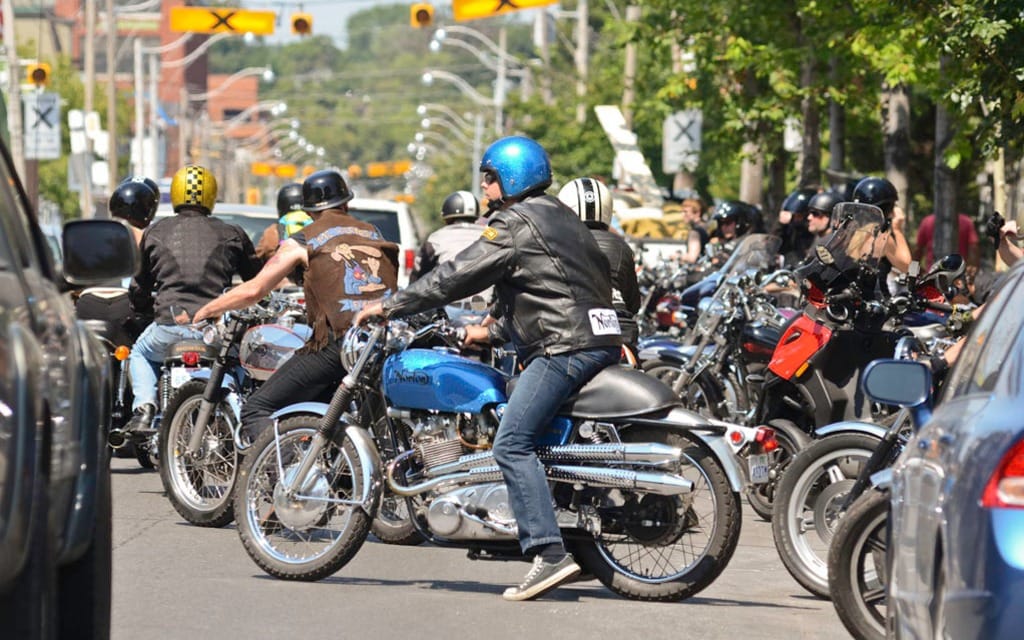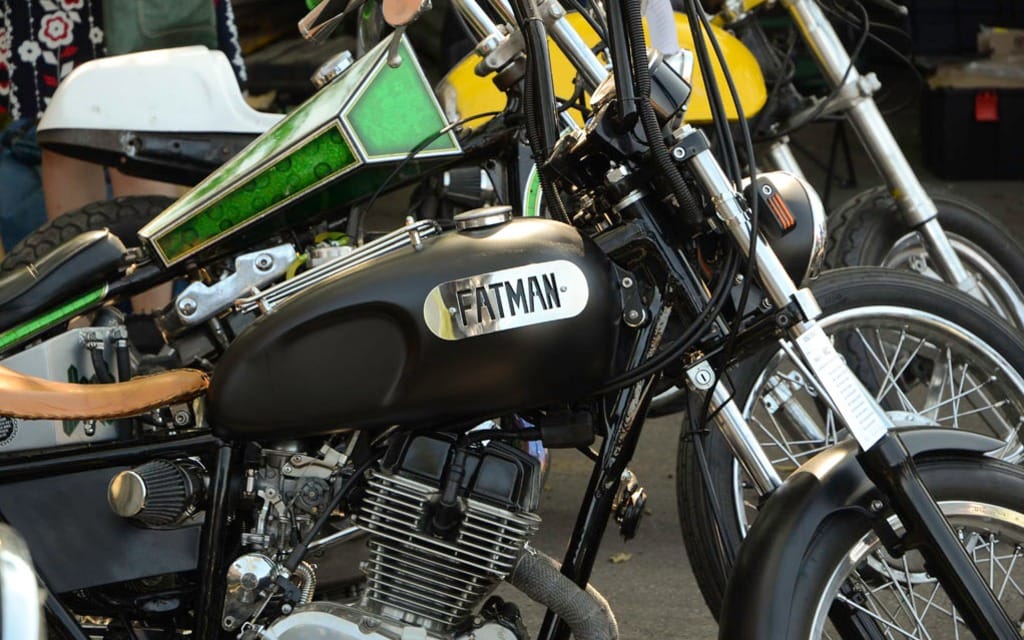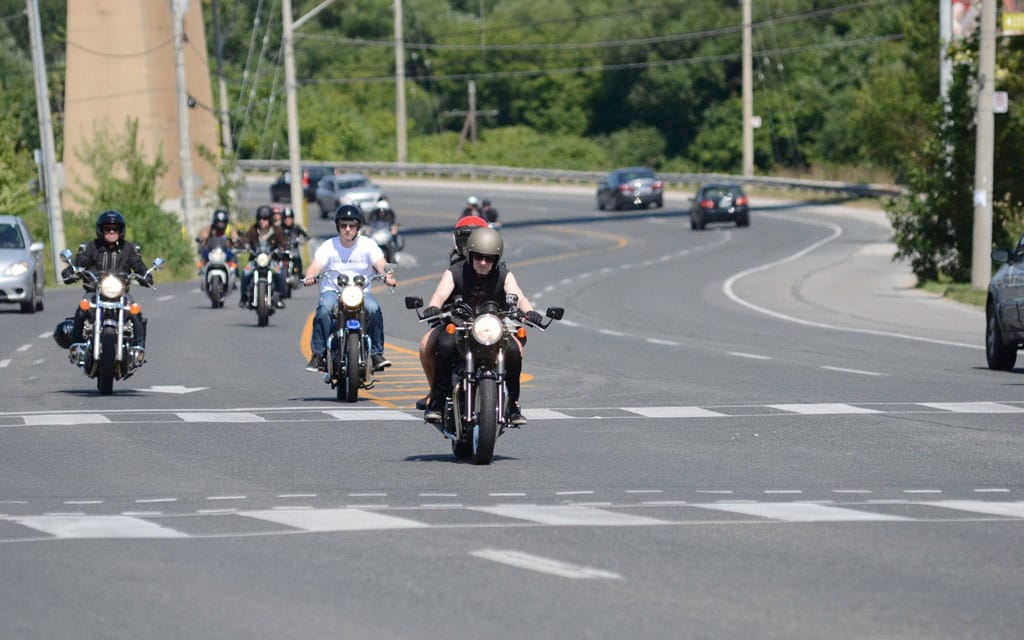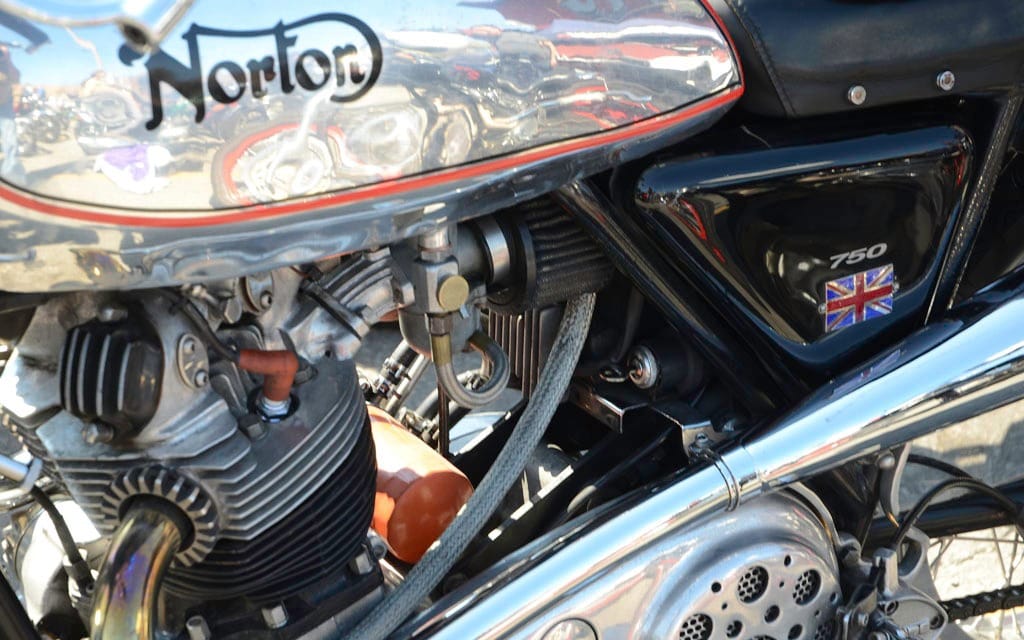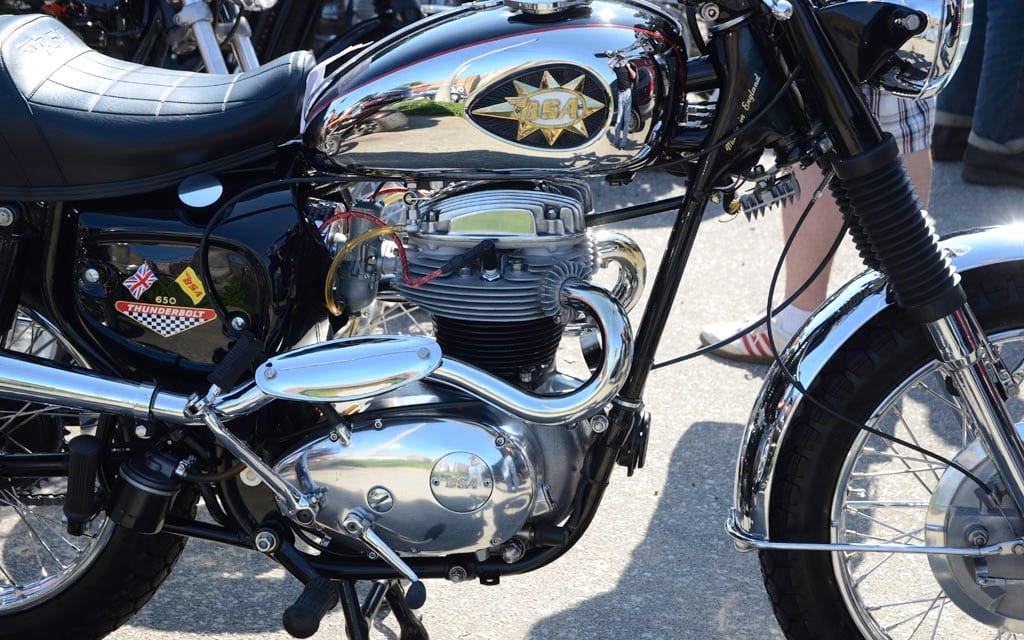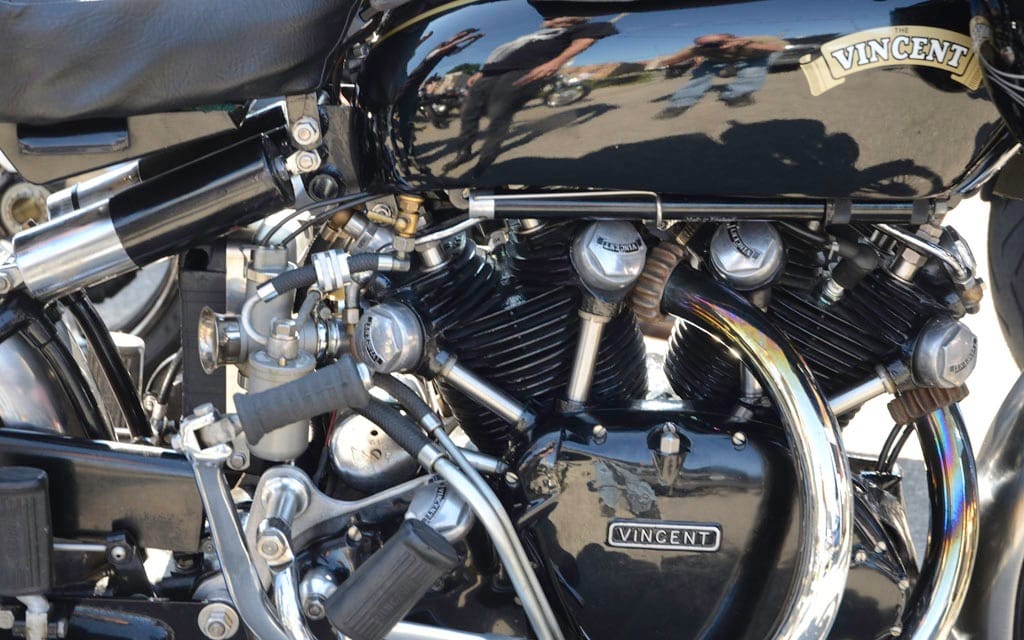Even if you don’t remember the mods and rockers, you’ve got something in common with them
For 28-year-old Josh Michaylow, the best thing about last summer’s Mods and Rockers gathering in Toronto was that he was wrong. “I thought it was gonna be a lot of pretentious people that were riding Triumphs or something and being in their own little cliques, kind of like high school,” he said. “But it wasn’t. It was like a really warm environment, I felt welcome—that’s what really appealed to me.”
Welcome, that is, even though his ’83 Virago was about as far removed from the Mods and Rockers archetype as a bluegrass fiddle—but that’s the point. The group may hold BSA motorbikes andLambretta scooters in unduly high regard, but they didn’t turn up their noses at a Yamaha proto-cruiser. “It didn’t matter what you were riding,” said Michaylow, who has since sold his Virago and bought a Harley Sportster. “Everybody was having a good time.”
“Think of it like a big house party, or a pub crawl,” said Michel Mersereau, one of four organizers for the event. “That’s one of the keys to success for us—to keep it fluid: here it is,show up, have a good time.” Unlike the mods and rockers clashes of Merry Olde England back in the glory days of the Kinks and the Who, there were few fistfights, if any, but much like those swaggering and costumed cacophonies in places like Brighton and Margate, there was a mix of chaos and uniformity in all of the bullshitting, drinking, riding, and envying behaviour that took place. (Wikipedia, on Mods and Rockers: The worst violence was at Brighton, where fights lasted two days and moved along the coast to Hastings and back; hence the Second Battle of Hastings tag. A small number of rockers was isolated on Brighton beach where they – despite being protected by police – were overwhelmed and assaulted by mods.)
There was no evidence of bad blood at the Duke pub in downtown Toronto on that August Saturday. Perhaps because, unlike the Brighton beach scene, any riders of scooters were heavily outnumbered; but more likely because it just wasn’t that kind of deal. Mersereau calls it a “cultural event,” and in some ways even a non-motorcycling event. It’s not that bikes aren’t a significant focus—the Duke’s parking lot overflowed onto the sidewalk and street with all kinds of motorcycles, some of which were awarded trophies—but motorcycles are only one component of the attraction to Mods and Rockers, said Mersereau.
“We found that we’re attracting people who don’t necessarily ride bikes at this point in their lives, but maybe have some sort of period affiliation or style affiliation, because when you think about mods and rockers, yeah, bikes are a big part of it, but it’s really a subculture, and there’s a whole bunch of music, and style and fashion influences that go along with it that really attract a lot of non-riders.”
There was very little organized riding involved in the Toronto event. There was a lot of standing around gazing at bikes, a lot of drinking at the Duke, and some burlesque and live rock music. But the essence of the thing was clearly a coming-together, a welcoming of all kinds of people who have some affection for old motorcycles and scooters, or even not-so-old, and who found in that environment an appealing mix of the like-minded. There was no room for the cliques predicted by Josh Michaylow or the brawls of ancient Britain simply because it was, as Mersereau said, a great big house party.
Outside the Duke, as at the Ossington Avenue assembly area earlier in the day, there were Harley-Davidsons, Hondas, Nortons, Triumphs, BMWs, a heterogenous mix that included most common brands. In the pub’s parking lot there was hardly room to turn a bike around, and the sun glittered off any number of customized motorcycles, but there were also dirty old scabs and unmodified 10-year-olds. There were vendors, and there were people: teenagers, adults, old people. Men, women, boys and girls. There was a dog.
But scooters? Not so much. “It’s overwhelmingly motorcycles,” said Mersereau. “And the scooters that do show up are typically modern scooters, fewer and fewer classic scooters. I started out in the mod revival scene in the mid to late ’80s, and my first bike was an old Vespa 150, and there was whole subcultural revival of that scene, and that’s really not something that’s occurred since then, I think.”
In the event’s single organized ride, a parade of bikes left Ossington in downtown Toronto, headed to an uphill part of north Toronto for a re-grouping, then set off to the Duke in another part of downtown T.O. The whole thing took around two hours, was interrupted by traffic collisions involving other people, and was the focus of both complaints and praise.
Kameron Cuk, who rode a customized CX500, said better road directions prior to the ride might have been useful, because riders were diverted at one collision scene, at least. “A few of the people I was following got lost and went down the wrong road.” Jason MacIntyre, who rode a ’61 Honda Dream, was also frustrated. “There were a few detours and we didn’t have a lot of blockers to block the traffic, so everyone got kind of split up.” Michaylow agreed, but also wished for longer planned routes. “I don’t know how many kilometres that was, but something a little longer. There was an accident and we all had to turn off, we got broken up into different packs, and I don’t know how many people there were (Mersereau estimated 240), but all lined up and riding like that would have been cool.”
Perhaps Mersereau and his pals could have thought to arrange escorts for unexpected traffic problems, but that really was a minor complaint. Michaylow, Cuk, and MacIntyre were overwhelmingly pleased with the event, and all three swear they’ll be back next year. But the unorganized nature of the event was planned. “This was our fifth year (in Toronto) and we did some changes this year,” Mersereau said. “We change it every year, but we’ve tried programming stuff, and we found that what people want to do is they want to come, they want to hang out, look at bikes, and they want to talk and they want to meet people, and they want to share stories, and we want to make it as unstructured as possible to allow people to do that.”
A reporter at the event would have observed long rows of motorcycles liked up on Ossington Avenue, old, new, in between, customized, stock, and in between. People in denim, leather, shorts, full riding outfits, and a whole lot of blue jeans, standing in large and small clusters, talking about the bikes in front of them, appearing to be quite happy just to be on the street among their own kind, whatever that meant. Later, at the Duke, the reporter would have seen all those bikes in the parking lot with people moving among them, looking, envying or pitying, taking their time about it. That was another thing—nobody seemed to be in a rush to go anywhere.
It was, said Mersereau, the largest gathering he had seen at a Toronto Mods and Rockers event. “The attendance numbers were huge. And this was actually the first year that we were able to—because of the vendor and sponsor support—able to do it as an absolutely free event.” Free, and in an important sense, unrestricted. “I think, and I think my fellow organizers would pretty much be on the same page,” said Mersereau, “there’s no shortage of vintage bike events or café racer events or even scooter events that people can go to (in Toronto), but what isn’t out there is a cultural event like ours. And I think that’s important because motorcycling is one of the few activities that can bring together so many diverse people from all different walks of life, and have one very passionate thing in common. So there’s a whole aspect of what motorcycling does in that respect, but if you broaden that out, I don’t care if you’ve never ridden a scooter in your life, or you’ve never ridden a Triumph or a Norton or even a vintage Japanese bike, most people like the Who, most people have seen Quadrophenia, a lot of people have seen the original cut of The Wild Ones, stuff like that. It’s the whole pop-cultural essence that goes along with it, the fashion, the music, and I think because of that phenomenon, that pop-cultural connection to riding bikes, I think that’s what makes it resonate more than anything else with such a diverse community.”
Michaylow, Cuk, and MacIntyre would probably agree that it resonates. “It was funny because I invited my buddy, and when we talked about it, he was like, Oh it’s a vintage motorcycle ride, and I’m like, Mine’s a 1983, it’s a vintage bike. My friend had a 2007 Dyna, he wasn’t sure. I’m like, Dude, just come down, everybody’s gonna be awesome.”
MacIntyre, who at 35 is way too young to remember the original mods and rockers, said he’s been into the culture for years. “I’ve always had a love of anything old.” But it was the warmth of the people there that really made it happen for him. “I think the best thing was—and I mean I got to, unfortunately, see it first hand when my bike broke down—everybody was on top of my bike trying to figure out what was going on.”
Cuk, who was born in 1974, said it was the open nature of the event that drew him—you could come on any sort of bike you liked. That, and its loose, unorganized nature: “Just ride and enjoy each other’s company and talk to each other—that was the best part, chatting with all the other owners, and finding out what they had done, or what their plans were, what their next bike was gonna be.”
For Michaylow, as it was for the others, the biggest draw, ultimately, was not the other bikes, but the other riders. Michaylow and MacIntyre rode their Virago and Dream to the event together, and a couple of hours before the start of the one organized ride, the Dream did what Dreams do—it uncloaked character. “When Jason’s bike broke down, we eventually had to bump-start it, but there were at least 10 to 15 guys coming out, like some dude hopped off his Harley and another guy hopped off a trike, and another guy hopped off his scooter, and everybody had their tools out and they’re like, okay let’s get to the bottom of this, and we got him riding.”
This was the fifth year for the Toronto Mods and Rockers event, and it won’t be the last. Rising attendance numbers probably guarantee that, but the event’s organizers have stumbled upon something the motorcycle manufacturers would pay for with their own blood: new blood. “We have our core community members who come out every year,” said Mersereau, “and it’s always great to see those people, but what’s really amazing is all the new faces every year. You hear people say they came in from Labrador, or Winnipeg, as far as California. We’ve got a regular who comes up from Ohio every year. But seeing the new faces, especially the young faces, people who are getting into the sport, on British and old Japanese bikes. It’s so accessible, especially with the vintage Japanese scene, it’s so accessible for these young kids who don’t have a lot of money, and maybe not too much building experience, but they’ve got access to this huge community of people who are willing to give them the right knowledge and give them parts, you know. We see a lot of young kids on these fantastic bikes that they’ve put together themselves. Actually, our winner of best British this year, is a guy we’ve never seen before, he shows up on this beautifully restored 68 BSA T-Bolt. Gorgeous bike, and I’ve been in the scene quite a number of years, and I’m thinking, Who did this? We finally located the guy to give him the prize and he said he’d never ridden before and found this basket case out in London, and just spent the winter on his own, going on-line, getting tips, and now here he is, he’s a new entrant into the scene, he’s brought himself into it, and that’s what we like to see.”
